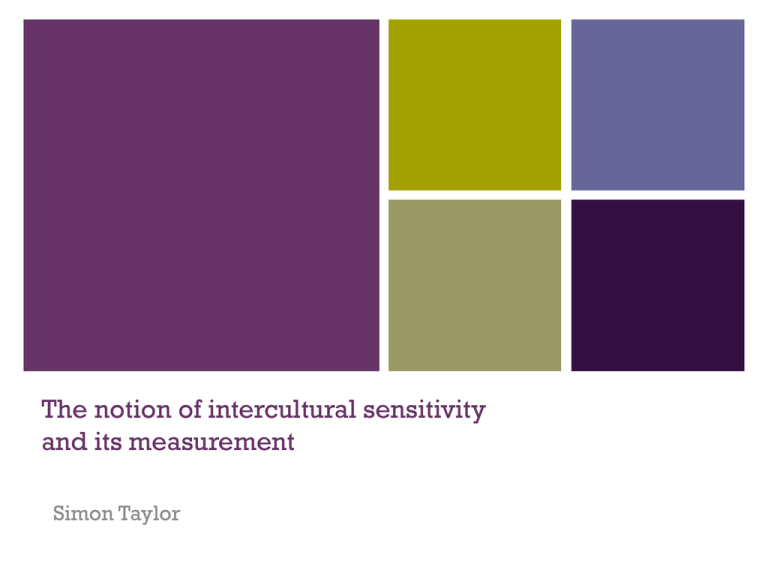Powerpoint presentation
advertisement

The notion of intercultural sensitivity and its measurement Simon Taylor Overview Starting points Culture and Global mindedness Definitions Intercultural sensitivity Measurement instruments Introduction to IDI IDI use in education IDI use at MIS The pros and cons of the IDI My Starting Points 1 Why? “Excellence in education for globally minded students” Faculty and staff need to understand, feel and live “global-mindedness” if we are to help students. Global mindedness heidisparkle.com My Starting Points 2 Global – mindedness IS NOT Internationalmindedness Culture IS A valid concept Globalmindedness and culture ARE Linked Definitions Intercultural … Awareness Learning Sensitivity Competence “Intercultural awareness, intercultural sensitivity Understanding and intercultural competence form the cognitive, affective and behavioural aspects of Education intercultural communication” Chen 1997 Intercultural Sensitivity Measurement Intercultural Sensitivity Measurement 4types Abbe, Gulick & Herman (2007) Self Reporting Multi dimensional Developmental Trait based Behavior Observational Fantini 2007 Intercultural Development Inventory (IDI) Developmental 1986 DMIS developed (Bennett 2004) 1998 IDI – based on DMIS developd (Hammer, Bennett and Wiseman (2003) Denial Polarization Minimization Acceptance Adaption Defense Reversal 55 100 Ethnocentrism 145 Ethnorelativitism IDI v3 – 50 questions and self reporting Hammer (2011) “4763 individuals from 11 distinct, cross cultural samples” Different languages Conclusions Perceived (PO) and Developmental Orientation (DO) Readability (Grade 10) Language transferability Predictive validity IDI use in Education Research results with teachers Sample American International School in South Africa “US school district” – 5 schools “US school district” – (9 schools) Hong Kong – 4 schools Range of Developmental Orientation (DO) 92.60 - 101.52 Author 90.95 - 98.10 Bayles 2009 96.00 - 110.00 DeJaeghere and Zhang (2008) Westrick and Yeun (2007) 91.32 mean Fretheim 2007 Fretheim, Bayles and Westrick and Yeun cited in Davies 2010 IDI at MIS 1 50 members of staff at MIS (Random) Perceived orientation 125.85 Developmental orientation of 103.94. 8 members of staff at MIS - Intercultural awareness Committee (Self selecting group) Perceived orientation 131.99 Developmental orientation of 114.68 IDI Pros and Cons The good The not so good Grounded theory Measures intercultural sensitivity Differential validity- Bias in introduction and questions 50 questions Self reporting “How do I answer?” questions Face validity -Ambiguity of questions Minimization bias Linearity Identifies development Raises cultural awareness Potential IDI use at MIS 2 Raising Intercultural Sensitivity Approaches ■ Recruit the right people ■ Offer professional development – Personal ■ Set the right culture – Systems and policies References Abbe, A., Gulick, L., & Herman, J., 2007. Cross-cultural competence in Army leaders: A conceptual and empirical foundation. Washington, DC. U.S. Army Research Institute. Bennett, J. 2004. Becoming Interculturally Competent [pdf]. Available at: http://www.newonline.org/resource/resmgr/mcw_ppt/becominginterculturallycompe. pdf [Accessed 25.2.12]. Davies, A., 2010. The Applicability of the intercultural development inventory for the measurement of intercultural sensitivity of teachers in an international school context. Thesis (Doctor of Education (EdD)), University of Bath. DeJaeghere, J. and Zhang, Y., 2008. Development of intercultural competence among US American teachers: Professional development factors that affect competence. Intercultural Education. 19(3), pp. 255-268 Fantini, A.E., 2005. About intercultural communicative competence: a construct [Electronic version]. Brattleboro, VT: School for International Training. [Accessed 20 December, 2011] http://www.sit.edu/SITOccasionalPapers/feil_appendix_e.pdf. References 2 Hammer, M., Bennett, R and Wiseman, R., 2003. Measuring intercultural sensitivity: The intercultural development inventory. International Journal of Intercultural Relations, 27 (2003), pp. 421-443. Hammer, M., 2011. Additional cross-cultural validity testing of the intercultural development inventory. International Journal of Intercultural Relations, 35 (2011), pp.474-487.









